Create and Use Workbooks in Excel is an essential skill for anyone working with spreadsheets. Whether you’re a beginner or an experienced user, mastering the creation and utilization of workbooks is fundamental for efficient data management and analysis. By understanding how to create new workbooks, organize data into multiple sheets, and utilize features like formulas, charts, and formatting, you can effectively handle various tasks ranging from simple calculations to complex financial modeling. Furthermore, knowing how to navigate and customize workbooks allows you to tailor Excel to your specific needs, improving productivity and accuracy in your work. With Create and Use Workbooks in Excel as the foundation of your spreadsheet proficiency, you can unlock the full potential of this powerful tool for organizing, analyzing, and presenting data.
This Tutorial Covers:
- What is Excel Workbook
- How to use a Workbook in Excel
- Opening and closing an existing workbook
- Creating a New Workbook
- Deactivating the Start Screen
- Various uses of Excel Workbooks
1. What is Excel Workbook?
An Excel Workbook is a file created and used in Microsoft Excel to store and organize data. It serves as the primary container for Excel worksheets, charts, and other data-related objects. A Workbook can consist of one or multiple worksheets, each represented by a tab at the bottom of the Excel window.
Workbooks provide a structured and efficient way to manage data, perform calculations, create charts, and analyze information. They offer a flexible and dynamic platform for organizing and manipulating data in a spreadsheet format.
Within a Workbook, users can input, edit, and format data in individual cells, apply formulas and functions for calculations, create charts and graphs to visualize data, and perform data analysis using Excel’s extensive range of tools and features. Workbooks can also be shared and collaborated on with others, allowing multiple users to work simultaneously on different worksheets or sections of the same Workbook.
By doing Excel workbooks utilization, users can effectively store, organize, and manipulate data, making Excel a powerful tool for tasks such as financial analysis, data modeling, project management, budgeting, reporting, and much more.
2. How to use a Workbook in Excel?
An Excel workbook is a file that contains one or more worksheets, providing a structured and organized way to store, manipulate, and analyze data.
In the next section of the tutorial, we will explore how to use Excel Workbook as well as create a new one.
/In the next section of the tutorial, we will explore the use of excel workbooks.
-
Opening and closing an existing workbook:
Opening and closing existing Workbooks in Excel is a fundamental task that allows you to access and work with your saved data.
Opening an Existing Workbook:
Follow these instructions to open a worksheet that you’ve previously created:
Step 1: First of all, select “Open” from the “File” menu.
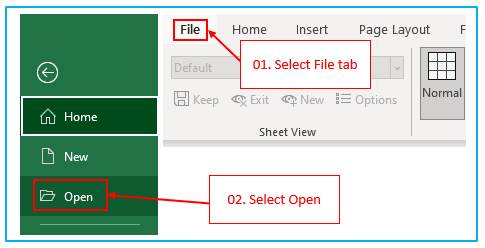
Step 2: You can view your most recent workbooks by selecting “Recent” from the menu. From here, you can open a worksheet right away.
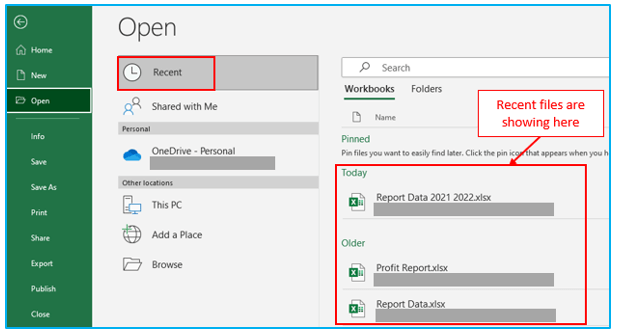
To open a worksheet that is not on the list, click “Browse”.
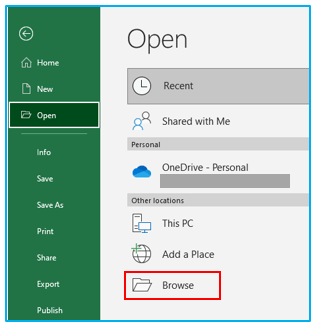
That is how you open a previously saved worksheet.
Closing an Existing Workbook:
Ensure that you have saved any changes you made to the Workbook. Excel will prompt you to do so if you haven’t saved your changes before closing.
Follow these instructions to close a worksheet that you’ve previously created:
Step 1: Click the upper-right X to close an Excel workbook. The active workbook is closed when you click the upper-right X while you have numerous open workbooks.

Alternatively, you can use the shortcut Ctrl + W to close the active Workbook.
If you have multiple Workbooks open in Excel, closing a Workbook will only close the active one. To close all open Workbooks, you can repeat the above steps for each Workbook or use the shortcut Ctrl + Shift + W.
Remember to save your changes before closing a Workbook to ensure that your data is preserved.
By following these steps, you can effortlessly open and close existing Workbooks in Excel, providing you with easy access to your saved data and facilitating efficient data management.
-
Creating a New Workbook:
Creating a new Workbook in Excel allows you to start a fresh file to store and organize your data.
Here’s a step-by-step guide on how to create a new Workbook:
Step 1: Launch Microsoft Excel on your computer.
By default, Excel opens a new blank Workbook. If you have a Workbook already open, you can create a new one by clicking on the “File” tab at the top-left corner of the Excel window.
Select “New” from the drop-down menu that displays. By doing so, a new Workbook with just one Worksheet will be opened.
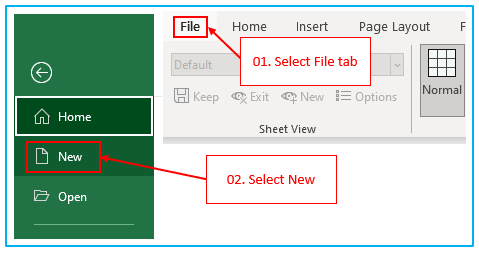
Alternatively, you can use the shortcut Ctrl + N to create a new Workbook.
By following these steps, you can effortlessly create a new Workbook in Excel and begin working with your data in a structured and organized manner.
3. Deactivating the Start Screen:
Excel displays a start screen that lists previously used Excel files and templates when you launch the program.
Deactivating the Start Screen in Excel allows you to bypass the initial screen that appears when launching Excel, providing a quicker and more streamlined start to your work.
Here’s a step-by-step guide on how to deactivate the Start Screen in Excel:
Step 1: Click on the “File” tab at the top-left corner of the Excel window.
In the menu that appears, select the “Options” button located at the bottom of the left-hand sidebar. The Excel Options dialog box will then be displayed.
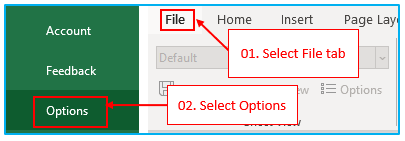
Step 2: Within the Excel Options dialog box, select the “General” tab on the left-hand side.
In the General tab, locate the section titled “Start up options.”
Under the “Start up options” section, uncheck the “Show the Start screen when this application starts” option.
Click the “OK” button at the bottom-right corner of the Excel Options dialog box to save the changes and close the dialog box.
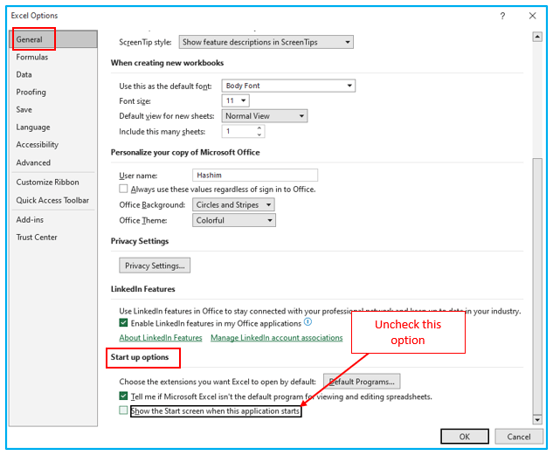
After deactivating the Start Screen, the next time you launch Excel, it will skip the initial screen and directly open a new blank Workbook or the most recent Workbook you were working on.
Deactivating the Start Screen can help expedite your workflow by eliminating the need to manually navigate past the Start Screen every time you open Excel.
By following these steps, you can easily deactivate the Start Screen in Excel and enjoy a more streamlined and efficient start to your work.
4. Various uses of Excel Workbooks:
Excel Workbooks offer a multitude of uses across various domains and tasks.
Here are some common applications and benefits of Excel Workbooks:
Data Organization: Workbooks provide a structured framework for organizing and managing data. You can use separate Worksheets within a Workbook to categorize and store different types of data, making it easy to navigate and locate information.
Data Analysis: Excel Workbooks offer powerful tools and functions for data analysis. You can perform calculations, apply formulas, and use built-in functions to analyze data, identify trends, calculate statistics, and derive insights from your datasets.
Financial Management: Workbooks are extensively used for financial management tasks. You can create budgets, track expenses, manage accounts, perform financial modeling, and generate financial reports using Excel’s functions, formulas, and data visualization capabilities.
Project Management: Excel Workbooks serve as valuable tools for project management. You can create project timelines, track tasks, manage resources, and monitor progress using Gantt charts, scheduling tools, and project management templates available in Excel.
Data Visualization: Workbooks allow you to visualize data using charts, graphs, and tables. Excel offers a wide range of chart types and customization options, enabling you to create visually appealing and informative visual representations of your data.
Collaborative Work: Excel Workbooks facilitate collaboration and teamwork. Multiple users can work on the same Workbook simultaneously, making it easier to share information, review and edit data, and collaborate on projects in real-time.
Reporting and Dashboards: Workbooks enable the creation of professional-looking reports and interactive dashboards. You can consolidate data from different sources, create summary reports, and build dynamic dashboards using features like PivotTables, conditional formatting, and data validation.
Data Import and Export: Workbooks allow you to import data from external sources such as databases, CSV files, and other Excel files. You can also export data from Excel to various formats, including PDF, CSV, and PowerPoint, for sharing and further analysis.
Data Cleaning and Manipulation: Excel Workbooks provide tools for data cleaning, manipulation, and transformation. You can filter and sort data, remove duplicates, apply data validation rules, and perform various data cleansing tasks to ensure data accuracy and consistency.
Custom Applications: Workbooks can be used to create custom applications using VBA (Visual Basic for Applications). With VBA programming, you can automate repetitive tasks, build custom functions, and create interactive user interfaces to enhance Excel’s functionality.
These are just a few examples of the diverse uses of Excel Workbooks. Excel’s versatility and extensive features make Workbooks a powerful tool for individuals and organizations across various industries and disciplines.
In conclusion, Excel Workbooks offer diverse uses and benefits, including data organization, analysis, visualization, and collaboration. By creating and managing Workbooks, you can effectively handle financial tasks, project management, data visualization, and reporting. Workbooks facilitate teamwork, data import/export, and data cleaning. With Excel’s extensive features, Workbooks empower you to make informed decisions and drive efficiency. Practice and explore the various functionalities to master the art of Excel Workbooks and unlock the power of data management. Embrace Workbooks and excel in your data-driven endeavors!
Application of Create and Use Workbooks in Excel
- Data Organization: Workbooks allow users to organize related data into separate sheets within a single file, enhancing clarity and accessibility.
- Task Segmentation: Users can create different workbooks for distinct tasks or projects, facilitating efficient workflow management.
- Data Analysis: Workbooks provide a platform for conducting data analysis using Excel’s wide range of functions, formulas, and tools.
- Report Generation: Users can compile data from multiple sources into a single workbook to generate comprehensive reports or presentations.
- Collaboration: Workbooks can be shared with collaborators, enabling simultaneous editing and real-time collaboration on data analysis projects.
- Data Backup: Saving data in separate workbooks provides a backup mechanism, ensuring data integrity and security against file corruption or loss.
You may be interested:
